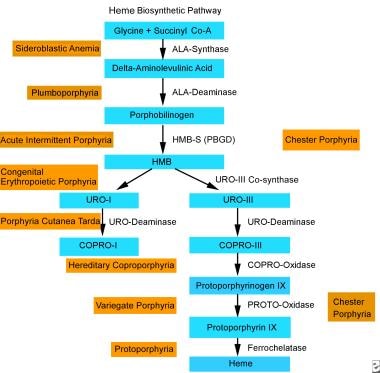Practice Essentials
Porphyrias are inborn errors of metabolism in which specific enzyme defects exist in the heme synthesis pathway. Chester porphyria is a unique type of porphyria, with the clinical picture of acute intermittent porphyria (AIP) and the biochemical defects of both acute intermittent porphyria and variegate porphyria (VP). [1]
Background
The first description of Chester porphyria is from a clinical observation made in 1963 by an anesthetist, Zorka Bekerus, in Chester, England (hence the name Chester porphyria). The index case, Peter Dobson, was a salmon fisherman born in 1867 in Chester. [2, 3] Numerous family members had the condition, and the family had coined the term Dobson's complaint to describe the mysterious illness. [4, 5]
Pathophysiology
Chester porphyria does not conform to any of the recognized types of acute porphyria (see image below).
 This schematic diagram of biochemical abnormality shows the sites of enzymatic defects of the various porphyrias on the left side of the diagram and the dual enzyme abnormality of Chester porphyria (deficiency of porphobilinogen deaminase [PBGD] and protoporphyrinogen oxidase) on the right. ALA = delta-aminolevulinate; COPRO = copro-porphyrin; HMB = hydroxymethylbilane; HMB-S = hydroxymethylbilane synthase; PROTO = protoporphyrin; URO = uroporphyrin.
This schematic diagram of biochemical abnormality shows the sites of enzymatic defects of the various porphyrias on the left side of the diagram and the dual enzyme abnormality of Chester porphyria (deficiency of porphobilinogen deaminase [PBGD] and protoporphyrinogen oxidase) on the right. ALA = delta-aminolevulinate; COPRO = copro-porphyrin; HMB = hydroxymethylbilane; HMB-S = hydroxymethylbilane synthase; PROTO = protoporphyrin; URO = uroporphyrin.
The urine porphyrin excretory pattern varies from the pattern of acute intermittent porphyria to variegate porphyria. Chester porphyria exhibits reduction in enzymatic activity of both porphobilinogen deaminase (an enzyme with reduced activity in acute intermittent porphyria) and protoporphyrinogen oxidase (an enzyme with reduced activity in variegate porphyria). Chester porphyria manifests with attacks of neurovisceral dysfunction common to all acute porphyrias. Unlike in variegate porphyrias, cutaneous photosensitivity is not a feature of Chester porphyria.
Etiology
Genetic studies have linked the Chester porphyria gene to chromosome arm 11q. [6] Precipitating factors of Chester porphyria attacks include the following drugs:
-
Barbiturates
-
Aluminum hydroxide
-
Tricyclic antidepressants
-
Alcohol
Other precipitating factors are as follows:
-
Smoking
-
Surgery
-
Metabolic abnormalities such as hyponatremia (also listed as a complication)
Epidemiology
The frequency of Chester porphyria is low, and it is only described in the city of Chester, England.
Prognosis
The mortality rate of Chester porphyria is high. Morbidity is significant. Many members of the Chester family were afflicted with hypertension and renal disease. Significant morbidity is associated with painful porphyric crises in patients affected with Chester porphyria. Tracing of the ancestry of the Chester family shows that 14 members had peripheral motor neuropathy; 6 of the 14 developed bulbar palsy, and 4 died as a result. [2, 3]
Complications of Chester porphyria include the following:
-
Malignant hypertension
-
Renal failure
-
Intracerebral hemorrhage
-
Bulbar palsy
-
Retinal hemorrhage
-
Hyponatremia (also listed as a precipitating factor)
-
Peripheral neuropathy
-
Myopathy
-
Coma and death
Patient Education
Genetic counseling and discussion about Chester porphyria are essential components of clinical management.
-
This schematic diagram of biochemical abnormality shows the sites of enzymatic defects of the various porphyrias on the left side of the diagram and the dual enzyme abnormality of Chester porphyria (deficiency of porphobilinogen deaminase [PBGD] and protoporphyrinogen oxidase) on the right. ALA = delta-aminolevulinate; COPRO = copro-porphyrin; HMB = hydroxymethylbilane; HMB-S = hydroxymethylbilane synthase; PROTO = protoporphyrin; URO = uroporphyrin.


